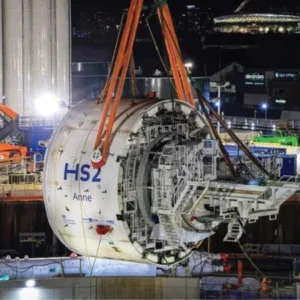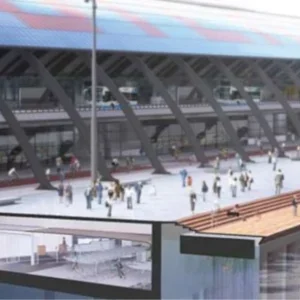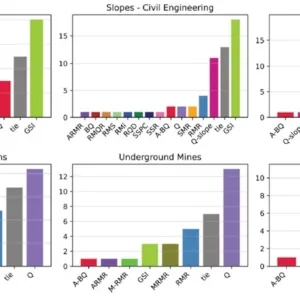Pipe jacking has been around a long time since it was first developed in the US with steel pipe in parallel with the widespread use of auger boring to pass utility lines under surface obstructions. Together with related techniques and terminology such as tunnel jacking, culvert jacking, structure jacking, and even bridge jacking, it provides an important range of techniques for creating, usually longitudinal, space from A to B.
It is important to note that it is primarily a support method for the final excavation, plus a means of carrying out its duties (e.g. sewerage or water transmission). However it is also inextricably linked with the means of excavation (mechanised or manual) and the use of the final structure to transmit the forces necessary to force the string of pipes or final structure through the ground, and perhaps the means of mechanised excavation as well, such as a shield machine. It can be seen that this places a lot of structural demands on the pipes, or whatever, being installed.
With the increase in mechanized methods there have been many adaptations of the basic technology, and overlaps with others such as auger boring and microtunnelling (of which it is part) and remote control tunnelling. It should not be confused with pipe ramming, or even pipe thrusting, in which there is no excavation of the ground within the pipe until it is fully installed.
Problems to overcome
In recent years research and development have been concentrated on overcoming the formerly frequent problems that could jeopardise a successful installation operation. These problems, and solutions, include overcoming friction (lubricants and how to apply them), improving soil properties (polymer conditioning, etc), negotiating both horizontal and vertical curves (guidance and monitoring), longer drives, and reducing the thrust loads on pipes (intermediate jacking stations, lubrication, etc). Failure to address these problems properly can easily result in pipe cracking or total failure requiring difficult, or maybe impossible, replacement work and possible rejection of the final structure.
In conjunction with this there has also been substantial high-level research into understanding the nature of the interaction of the equipment, pipes and the ground being passed through, whether along the pipe or at a mechanised face, and how this might be improved for greater efficiency and security. There has also been work on improving pipe design to withstand the loads involved; although there have been suitable pipes available on the market for many years providing they are matched correctly to the equipment used.
Lubrication
The properties and uses of bentonite are well known in the tunnelling and drilling industries, and these include the lubrication of exterior pipe walls when jacking. A major advantage is that the bentonite mix, based on a natural clay, is generally chemically inert and non-polluting. The bentonite slurry in injected through valved pipes in the installed pipe walls at the required intervals through the pipe ‘string’ being jacked. After hydrating the mix adequately using high shear mixing, delivery is by positive displacement pumps.
At first injection was manually controlled as required when excessive friction was encountered, but automatic injection according to planned performance of the whole operation has been used in recent years. Belgium-based specialist contractor Denys reports it has been using automatic lubrication for more than seven years.
The bentonite lubricant mix must be right for purpose and a trial mix should be undertaken. The CMS Pozament division of Tarmac recommends that for pipe jacking one tonne of dry bentonite will produce 12.8m3 of slurry.
Load monitoring
While it is easy to measure the pressures in jacking equipment, it has previously been difficult to assess the actual forces to which pipes are subjected, especially, for example, when a substantial distance from the jacking station or on a curve or misalignment.
In conjunction with the Aachen RWTH, Herrenknecht has been developing a pipe joint sensing and monitoring system called the Online Load Control (OLC). It has already been used in some pipe jacking applications including the Maerzenbach hydropower scheme in the Austrian Alps. Using an AVN1600TB mechanised shield, jacked 863m in usually hard, abrasive ground. The route included vertical and horizontal curves, a difference in elevation of 80m and at depths as much as 80m. The OLC senses and identifies critical loads at the installed pipe joint and calculates the maximum allowable jacking load in real time.
Pipeline push
Another recent development by Herrenknecht combines features of pipe jacking with horizontal directional drilling rigs. The Pipe Thruster assists the installation of ‘continuous’ steel pipelines that, with conventional directional drilling, would rely mainly on the pullback force available from the drilling rig.
A recent application was for passing a ‘continuous’ casing pipe for a gas transmission pipeline under the Godavari River in Rajahmundry, India. The contractor, Zueblin International, used the 550-t Pipe Thruster on either bank of the river to reach an island revealed in the centre of the river during the dry season. A total of 2475m of 48in.- (1220mm) diameter casing pipe was installed successfully at higher progress rates (up to 5m/minute) than conventional means, allowing the job to be completed before the next monsoon and flooding of the central island.
Sorting slurry
The UK Pipe Jacking Association (the PJA) and its members have supported manyresearch programmes including the work on soil behaviour, friction and pipe loading at Oxford and Cambridge universities outlined above. It also works with the key bodies involved with UK education and training, specifications and standards including, also, the departments of civil engineering at Leeds and Newcastle universities as well as Oxbridge, the BSI and CEN, the Constructon Industry Training Board, the BTS, TRL and H&SE.
The latest programme is to tackle a problem common to many tunnelling projects: efficient management and disposal of spoil, especially slurry. Depending on the amount of fines, it can take a long time for excavated material, aggravated by clay, to settle out in tanks, even with using flocculant. This may result in the need for cyclones, filters, and presses to separate solids and water. In addition there may be requirements for water treatment before discharge, all increasing the overall costs. Thus any measures that can economically improve separation procedures are to be welcomed. This does not remove the need for increasingly valuable disposal sites, but it may reduce the volume needing to be disposed of.
Intelligent guidance
The scope of pipe jacking is greatly increased if the route is not restricted to a straight line, vertically or horizontally. Conventional laser guidance allows adjustments to keep a straight pipe jack on route, butmore sophisticated systems allow the installation of curves to pass under obstacles, follow curved surface routes, or avoid deep foundations. Curved mechanised excavation pipe jacking (microtunnelling or remote-control tunnelling) has been practised, where required, formany years in Germany and Japan. Recently VMT announced completion of what is believed to be the first planned curvedmicrotunnel in the US. Northeast Remsco Construction completed a 183m(600-FT) drive including a 414m(1359ft)-radius bend in nine days using a Herrenknecht AVND 1800ABMTBMfitted with a VMT SLSmicrotunnelling LT guidance system. The purpose of the curve was to avoid known complex obstacles on the route, necessitating several revisions of the route.
Moveable structures
The installation of relatively large-dimension, often rectangular-section, structures such as culverts, underpasses and subways under surface obstructions such as roads and railways, which may remain active, is something of a niche pursuit within the jacking world. As such there are a few well-known practitioners with key experience. These include the contractor BAM-Nuttall (Doug Allenby), John Ropkins and James Thomson. Not only are the sections installed much larger than with conventional jacking, they can also be inserted close below the existing infrastructure.
James Thomson has been involved with jacking pipes and structures since the 1960s, having pioneered jacking in the UK and Singapore, and developed various techniques for structure jacking including the drag-sheet to reduce friction; a possiblemajor problem when trying to avoid damaging interaction with adjacent structures such as a railway. He has recently set up a new company, Jacked Structures SA, in Geneva to specialise in offering engineering and construction management expertise. Jacked Structures points out that jacking can be used to create irregular openings as well as themore usual regular sections in large dimensions.
John Ropkins has worked on some of the largest projects including jacked box tunnel sections for the ‘Big Dig’ highway project in Boston, US, the largest jacked box tunnel in the UK at Downey, near Maidenhead (with Nuttall), and the first jacked box tunnel under a motorway in the UK, at the MI junction 15A, Northampton.
The Herrenknecht Pipe Thruster for assisting the installation of long steel pipes Inside the first planned curved pipe jack in the United States [Photo:VMT] Pipe jacking as used to create a larger underground structure for a Brussels rail route [Photo: Denys]






